1. Why do we need to classify living things?
Life on Earth has existed for about 3.8 billion years. Over that course of time, as many as 4 billion species may have existed. Currently, it’s estimated that Earth has about 8.7 million living species. About 1.9 million species have been identified and described.
To organize any large set of things, you need a classification system. “To classify” is to arrange things into groups or categories based on their shared qualities. Taxonomy is the branch of biology concerned with classification. In this tutorial, you’ll learn how taxonomy is done. As you do, you’ll become a much better evolutionary thinker.
2. Naming Species

During the mid-1700s, a Swedish botanist, zoologist, and physician named Carl Linnaeus developed the foundations of the system of taxonomy that we use today. One of Linnaeus’ contributions was creating a system for naming species (a group of organisms that can interbreed to produce fertile offspring). In the Linnaean system, every species has a two-part name. For example, our species’ name is Homo sapiens. Not every species’ name means something, but ours does. It means “wise man” (Homo = man; sapiens = wise).
The first part of a species name identifies a genus. A genus is a group of closely related species. In our case, the other members of our genus — Homo — are extinct. The second part of the name is the specific epithet. For the human species, the specific epithet is sapiens.
Here are three more features of the Linnaean species-naming system:
- Species names are in Latin and italicized.
- The genus begins with a capital letter (as in “Homo“)
- The specific epithet begins with a lowercase letter.
The plural of genus is genera. Here are a few more examples of species and genera.
- Dogs are in the species Canis lupus. Canis lupus includes both dogs and wolves.
- Coyotes (Canis latrans) are In the same genus as dogs and wolves (Canis) but are different enough to be put in their own species.
- Apples are Malus domestica. Other trees in the Malus genus produce crabapples, which are generally too sour to be eaten raw.
- If you live in the United States and have ants in your house, it’s very likely to be the Argentine ant, Linepithema humile. That species is native to South America but has been steadily expanding into North America.
Because the names in the Linnaean system have two parts, the system is called binomial nomenclature. You’ll also see these names referred to as binomials, scientific names, or Latin names.
Why does the Linnaean system use Latin names instead of common names (such as dog, robin, rose, redwood tree, and sword fern)? It’s because common names are imprecise. For example, if you live in North America, the robin in front of your house or apartment is a member of the species Turdus migratorius. But if you’re in Europe, what’s called a robin is the species Erithacus rubecula. The two robins are not closely related.
| Common name | Robin | Robin |
| Region | North America | Europe, North Africa |
| Scientific name | Turdus migratorius | Erithacus rubecula |
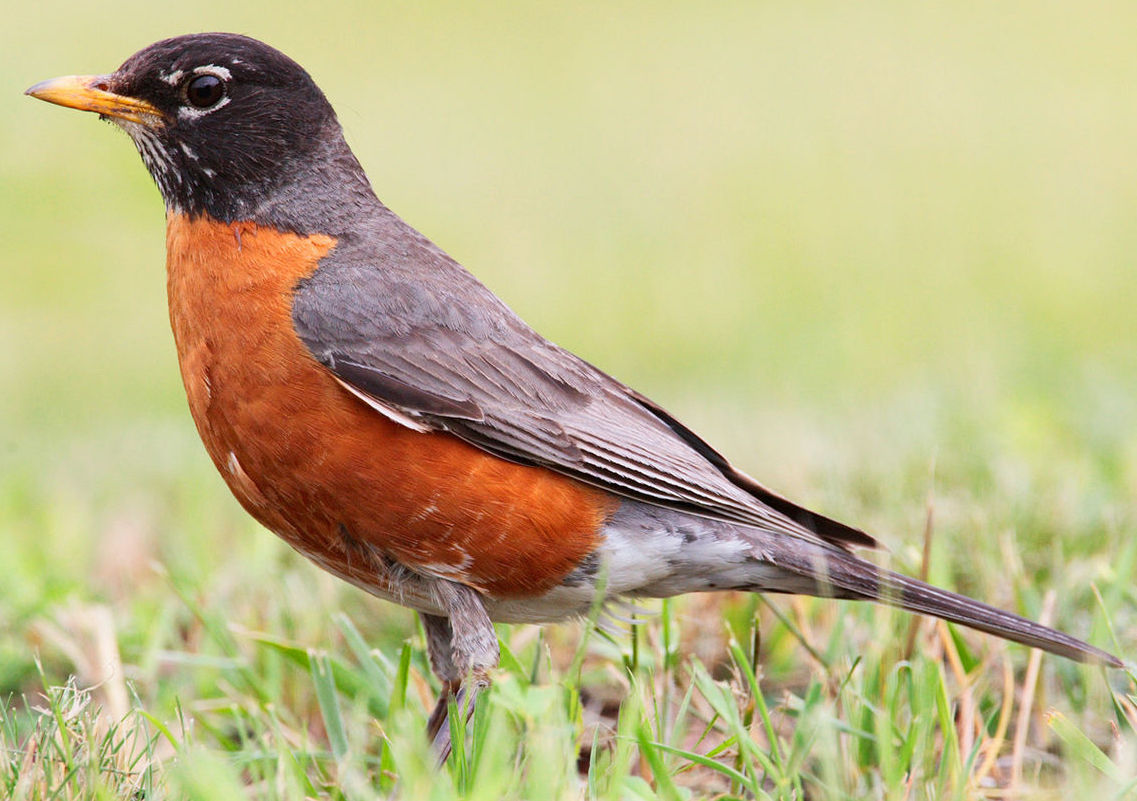 |
 |
Here’s another example. The animal that’s called an anteater on 3 different continents is not the same species.
| Common name | Spiny Anteater | Cape Anteater | Giant Anteater |
| Region | Australia | Africa | South America |
| Scientific name | Tachyglossus aculeatus | Orycteropus afer | Myrmecophaga tridactyla |
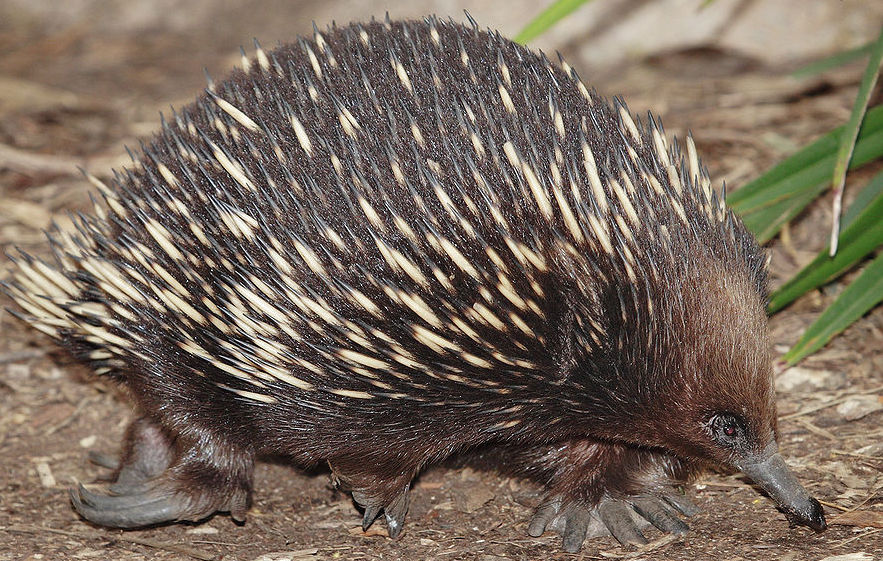 |
 |
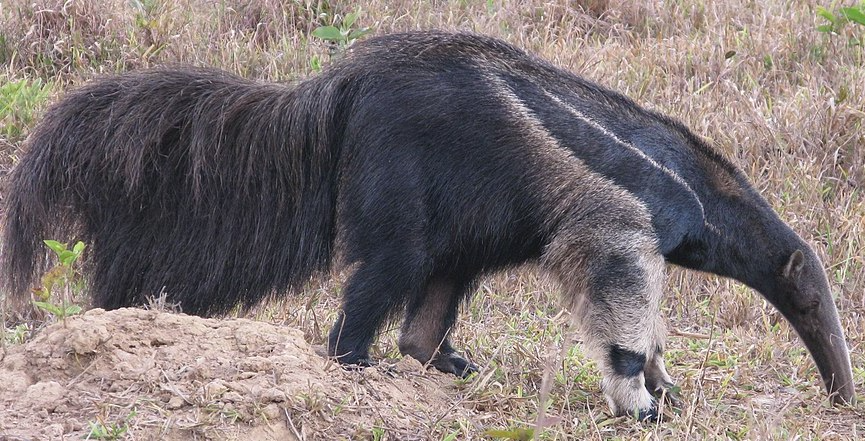 |
With binomial nomenclature, there’s no confusion.
3. Flashcards: Naming Species
[qdeck bold_text=”false” qrecord_id=”sciencemusicvideosMeister1961-Naming species (v2.0)”]
[h]Flashcards: Naming species
[q]The branch of biology that’s concerned with classification.
[a]taxonomy
[q]The estimated number of species currently existing on Earth.
[a]8.7 million
[q]Review: A group of organisms that can successfully interbreed to produce fertile, healthy offspring is a
[a]species
[q]The first part of a species’ two-part name indicates the ____________.
[a]genus
[q]The second part of a species’ name is the
[a]specific epithet
[q]In the Linnaean system, the language used to name species is
[a]Latin
[q]The two-part naming system used in biological classification is known as
[a]binomial nomenclature
[q]What’s the advantage of scientific naming over the common names we have for species?
[a]Scientific names are precise. By contrast, the same common name (such as “robin” or “anteater”) is often used for different species.
[/qdeck]
4. Classifying species into groups above the species level
Now that we know how to name species, we can look at how they can be organized into groups.
The system that Linnaeus developed uses hierarchical categories. A hierarchy is a system with ranks or levels. For example in a system like an army, a private is the lowest rank. There are more privates than any other type of soldier. Above a private is a sergeant, and there are fewer sergeants than privates. The next rank up is lieutenant. This hierarchy continues up to general, of which there are very few.
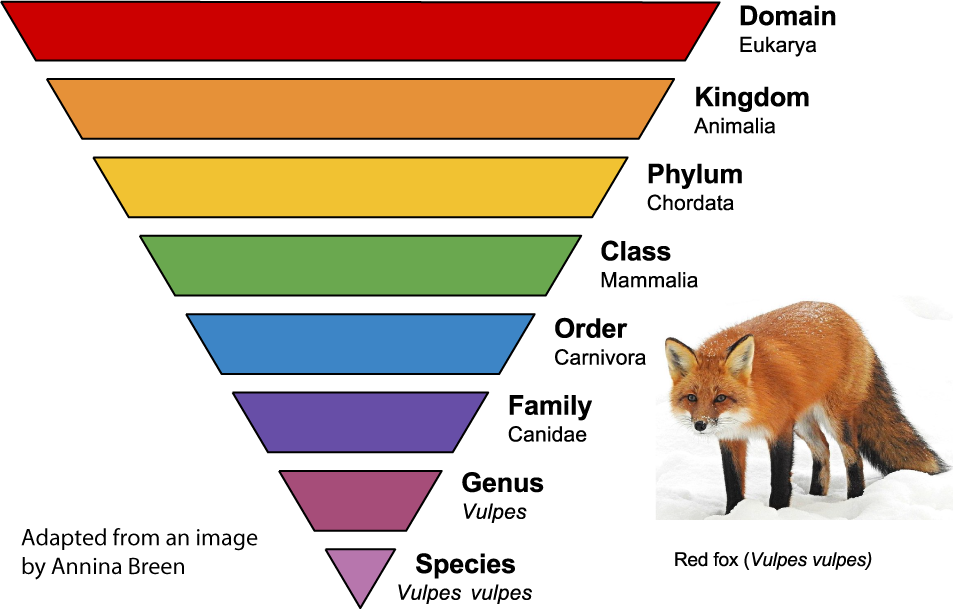
Here are the classification categories above the species level that were developed by Linnaeus:
- Related species are grouped into a common genus.
- Related genera (plural of genus) are grouped into families.
- Related families are grouped into orders.
- Related orders are grouped into classes
- Related classes are grouped into phyla (plural of phylum)
- Related phyla are grouped into kingdoms
- Related kingdoms are grouped into domains.
Take a minute to study the image on your right which shows how the Red Fox, Vulpes vulpes, is classified. Note both the categories (species, genus, family, etc.) and the specific groups (Vulpes vulpes, Vulpes, Canidae, etc.).
The specific groups at each level are called taxa (plural for a taxon). How are the taxa different from the categories? Think of how you would respond if someone asked you where you lived. You could answer with many levels of specificity: your street, your neighborhood, your town, your state, your country. Those levels of specificity are equivalent to categories. Your specific answer (Main Street, Passaic, New Jersey, or the United States) is equivalent to a taxon.
The term taxon, by the way, should be easy to remember, because what we’re learning about is taxonomy: the science of classifying organisms. To show this classification system in action here’s some information about the taxa into which the red fox is classified. If you’re interested, you can follow the links to learn more about each taxon. All of these links open in a separate browser tab.
- Species: Vulpes vulpes. This is the largest species of fox. It ranges throughout the Northern hemisphere.
- Genus: Vulpes: 12 species of foxes.
- Family: Canidea: 34 species including those in the genus Vulpes, plus wolves and dogs, coyotes, jackals, and other types of wild dogs.
- Order: Carnivora: At least 279 species of the dog-like Canidae, plus cats, bears, hyenas, mongooses, bears, raccoons, pinnipeds (seals and sea lions), and others.
- Class: Mammals: About 6400 species of species that have hair and provide milk to their young. Includes Carnivora, plus rodents, whales, primates, bats, elephants, kangaroos, etc.
- Phylum: Chordates: About 65,000 species of mammals, birds, fish, reptiles, and amphibians, plus a few others.
- Kingdom: Animals: About 1.5 million species have been described. It’s estimated that there are over 7 million animal species. In addition to chordates, this taxon includes phyla such as mollusks (clams, octopi, snails); arthropods (insects, spiders, crabs); segmented worms (earthworms); echinoderms (sea stars, sea urchins), and cnidarians (jellyfish and anemones
- Domain: Eukaryotes: In addition to animals, this includes plants, fungi, and many kingdoms of single-celled organisms with complex, nucleated cells.
If you need to memorize the classification categories, you can use these mnemonics (memory techniques). The first letter of each word should remind you of Domain, Kingdom, Phylum, Class, Order, Family, Genus, and Species.
- Daring kings play chess on fine gray satin.
- Dear King Phillip came over for good soup.
5. Categories (and a few taxa) to know: Species, Genus, and Domain
As an AP Bio student, you probably won’t be required to memorize all of the categories. But you should know three: species, genus, and domain.
Here are definitions for each of these:
- Species: For species that reproduce sexually, a species is a group of organisms that can interbreed to produce healthy, fertile offspring. Asexual species are classified by similarities in form, evolutionary history, or ecological role. As stated above, the Earth is estimated to have about 8.7 million species (though only a fraction have been identified).
- Genus: A group of related species. Earth’s species are organized into about 300,000 genera (source: Wikipedia)
-
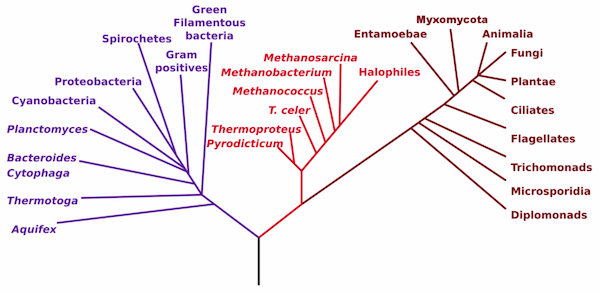
The three domains: Bacteria, Archaea, and Eukarya Domain: You were introduced to the three domains when we learned about the origins of cellular compartmentalization. A domain is a group defined by similar cell types and other basic biological features, such as the type of ribosome. The Domain is the most inclusive classification category, and includes only three taxa:
- Eukarya (also spelled Eucarya). This is the domain of eukaryotes: organisms with large, complex cells that contain mitochondria, a nucleus, and an endomembrane system. Eukaryotes emerged about 1.8 billion years ago through a cellular merger between cells from the other two domains (Archaea and Bacteria). Classified within the Eukarya are the plant, animal, and fungi kingdoms, along with algae and numerous kingdoms of single-celled organisms.
- Bacteria and Archaea
- These are the most ancient domains: they’ve been around since the emergence of life, about 3.8 billion years ago.
- Organisms in both of these domains are unicellular, and their cells are generally smaller and less complex than eukaryotic cells. Both bacterial and archaeal cells have a prokaryotic structure: there’s no distinct nucleus or endomembrane system.
- Despite these similarities, bacteria and archaea are quite different from one another. The differences involve distinct metabolic pathways, ribosomal structure, cell membrane structure, and DNA packaging.
- Being able to distinguish between these two kingdoms is outside of the scope of AP Biology. But if you want to learn more, consult this page from Treehugger, or this page from Microbnotes.
6. Flashcards: Classifying Species
[qdeck bold_text=”false” qrecord_id=”sciencemusicvideosMeister1961-Classifying Species (v2.0)”]
[h]Flashcards: Classifying Species
[q]What are classification categories? List as many categories as you can remember (there are seven).
[a]Categories are the levels into which we classify species. They include domain, kingdom, phylum, class, order, family, genus, and species.
[q]Define genus
[a]Genus: A group of related species.
[q]What’s a taxon?
[a]A taxon is a specific group within any biological category.
[q]The classification categories, from most general to most specific, are
[a]Domain, Kingdom, Phylum, Class, Order, Family, Genus, and Species. Note that you can use the memory trick “Dear King Phillip Came Over For Good Soup” to help you memorize these.
[q]What are the three domains?
[a]The three domains are bacteria, archaea, and eukarya.
[/qdeck]
7. Checking Understanding: Naming and Classifying Species
[qwiz qrecord_id=”sciencemusicvideosMeister1961-Naming and Classifying Species (v2.0)”]
[h]Naming and Classifying Species Quiz
[q] In the Linnaean system, the North American Robin has the binomial Turdus migratorius . Turdus is the [hangman]
[c]IGdlbnVz[Qq]
[q] In the Linnaean classification system, the domain is the most [hangman] and inclusive category.
[c]Z2VuZXJhbA==[Qq]
[q] In the Linnaean classification system, the species is the most [hangman] category.
[c]c3BlY2lmaWM=[Qq]
[q multiple_choice=”true”] Of the taxa listed below, which would have the most species?
[c]IENob3 JkYXRh[Qq]
[f]IEV4Y2VsbGVudC4gQ2hvcmRhdGEgaXMgYSBwaHlsdW0sIGFuZCB0aGF0JiM4MjE3O3MgdGhlIG1vc3QgaW5jbHVzaXZlIHRheG9uIG9mIHRoZSB0aHJlZSBsaXN0ZWQgYWJvdmUu[Qq]
[c]IE1hbW1hbGlh[Qq]
[f]IE5vLiBNYW1tYWxpYSBpcyBhIHRheG9uIGF0IHRoZSBjbGFzcyBsZXZlbC4gVGhlcmUmIzgyMTc7cyBhIG1vcmUgaW5jbHVzaXZlIHRheG9uIG9uIHRoaXMgbGlzdC4=[Qq]
[c]IENhcm5pdm9yYQ==[Qq]
[f]IE5vLiBDYXJuaXZvcmEgaXMgYSB0YXhvbiBhdCB0aGUgbGV2ZWwgb2YgJiM4MjIwO29yZGVyLiYjODIyMTsgU2VlIGlmIHlvdSBjYW4gZmluZCBhIG1vcmUgaW5jbHVzaXZlIHRheG9uLg==[Qq]
[q]Linnaeus’s system for naming species is called [hangman] nomenclature
[c]Ymlub21pYWw=[Qq]
[q]The science of classifying species is known as [hangman]
[c]dGF4b25vbXk=[Qq]
[q]The most general of the classification categories includes just three taxa. One of these is the eukaryotes. This category is the [hangman]
[c]ZG9tYWlu[Qq]
[q]A group of related species makes up a [hangman]
[c]Z2VudXM=[Qq]
[q]The domain that includes animals, plants, and fungi, plus many single-celled organisms is the domain [hangman]. Hint: Use “k” for the third letter.
[c]RXVrYXJ5YQ==[Qq]
[/qwiz]
What’s next?
Proceed to Topic 7.9, Part 2: Clades and Phylogenetic Trees, the next tutorial in AP Bio Unit 7 (Evolution).
